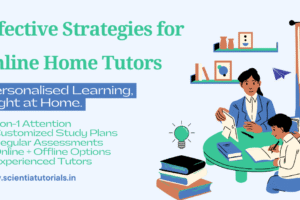
Teaching Tips for Home Tutors: Identifying and Addressing Learning Gaps in Home Tutoring
In today’s fast-paced educational landscape, home tutors play a pivotal role in supporting students’ learning journeys. One of the most significant challenges tutors face is identifying and addressing learning gaps. These gaps can hinder a student’s academic progress and confidence. By adopting effective strategies, tutors can ensure that their students receive the personalized attention they need to succeed. This article provides essential tips for home tutors on how to identify and address learning gaps effectively.
Understanding Learning Gaps
What Are Learning Gaps?
Learning gaps refer to the discrepancies between a student’s current knowledge or skills and the expected proficiency levels. These gaps can arise from various factors, including:
- Absenteeism: Frequent absences from school can lead to missed lessons and crucial information.
- Learning Disabilities: Some students may struggle with specific subjects due to underlying learning disabilities.
- Lack of Engagement: If students are not engaged, they may not grasp concepts fully, leading to gaps in understanding.
- Pacing Issues: Students may find the pace of classroom instruction too fast or too slow, leading to confusion or boredom.
Why Identifying Learning Gaps is Important
Identifying learning gaps is crucial for several reasons:
- Tailored Instruction: Recognizing these gaps allows tutors to create targeted lessons that meet students’ specific needs.
- Boosting Confidence: Addressing gaps helps to build a student’s confidence, making them more willing to participate and take on challenges.
- Enhancing Academic Performance: By filling learning gaps, students can improve their overall academic performance, leading to better grades and increased motivation.
Tips for Identifying Learning Gaps
1. Conduct Diagnostic Assessments
Before beginning tutoring sessions, conducting diagnostic assessments is essential. These assessments help identify students’ strengths and weaknesses, allowing tutors to gauge their starting point. Consider the following approaches:
- Pre-Assessment Tests: Administer tests in specific subjects to evaluate the student’s current knowledge level.
- Informal Assessments: Use quizzes, games, and oral questioning to informally assess comprehension and skills.
- Observation: Pay attention to students’ problem-solving approaches during tutoring sessions to spot misconceptions.
2. Communicate with Parents and Teachers
Parents and teachers can provide valuable insights into a student’s learning history. Establishing open communication can help tutors understand:
- Past Academic Performance: Parents can share report cards and feedback from teachers about the student’s strengths and weaknesses.
- Behavioral Insights: Parents can provide information about the student’s attitude towards learning, motivation levels, and any observed difficulties.
3. Encourage Self-Assessment
Promoting self-assessment among students can help them recognize their learning gaps. Encourage students to reflect on their understanding by asking questions like:
- What topics do you find difficult?
- Which subjects do you feel most confident in?
- What strategies do you use when studying?
4. Monitor Progress Regularly
Continuous monitoring is vital in identifying any new learning gaps that may arise. Regularly evaluate students’ progress through:
- Formative Assessments: Use quizzes and activities throughout the tutoring sessions to gauge comprehension.
- Progress Tracking: Maintain a record of the student’s achievements and areas needing improvement.
Strategies for Addressing Learning Gaps
1. Customize Learning Plans
Once learning gaps are identified, it’s essential to create customized learning plans tailored to the student’s needs. Consider the following steps:
- Set Specific Goals: Define clear, measurable objectives for each tutoring session, focusing on bridging identified gaps.
- Incorporate Diverse Learning Styles: Utilize various teaching methods, such as visual aids, hands-on activities, and discussions, to accommodate different learning styles.
2. Utilize Targeted Resources
Using targeted resources can help address specific learning gaps effectively. Consider the following:
- Workbooks and Worksheets: Use subject-specific workbooks that focus on areas needing improvement.
- Online Resources: Incorporate educational websites, videos, and apps that provide additional practice and explanations.
- Manipulatives: For younger students or those struggling with math, manipulatives can offer hands-on experiences to reinforce concepts.
3. Foster a Growth Mindset
Encouraging a growth mindset in students is crucial for overcoming learning gaps. Help students understand that:
- Mistakes Are Part of Learning: Emphasize that making mistakes is a natural part of the learning process.
- Effort Leads to Improvement: Encourage them to see effort as a pathway to growth rather than a fixed ability.
4. Break Down Concepts
When addressing learning gaps, it’s essential to break down complex concepts into smaller, manageable parts. This approach helps prevent students from feeling overwhelmed. Strategies include:
- Chunking Information: Present information in small segments, allowing students to master each part before moving on.
- Using Scaffolding Techniques: Provide temporary support (like guided practice) to help students understand new concepts before gradually removing that support as they become more proficient.
5. Encourage Active Learning
Active learning techniques can enhance understanding and retention of material. Some effective methods include:
- Interactive Discussions: Engage students in discussions that encourage them to think critically about the subject matter.
- Group Work: If appropriate, have students collaborate on projects or problems, allowing them to learn from each other.
6. Provide Regular Feedback
Constructive feedback is essential in helping students recognize their progress and areas for further improvement. Ensure that feedback is:
- Timely: Provide feedback immediately after assignments or assessments to reinforce learning.
- Specific: Be clear about what the student did well and where they can improve.
- Encouraging: Highlight strengths and improvements to motivate students.
7. Involve Parents
Involving parents in the tutoring process can create a supportive learning environment. Strategies for engaging parents include:
- Regular Updates: Provide parents with updates on their child’s progress, including successes and areas for growth.
- Home Practice: Suggest activities or resources for parents to use at home to reinforce learning.
Conclusion
Identifying and addressing learning gaps is a critical aspect of effective home tutoring. By implementing the strategies outlined in this article, home tutors can create a tailored and supportive learning environment that fosters academic success. Understanding the unique needs of each student and providing personalized instruction will not only bridge learning gaps but also enhance students’ confidence and motivation. With dedication and the right approach, home tutors can make a lasting impact on their students’ educational journeys.


